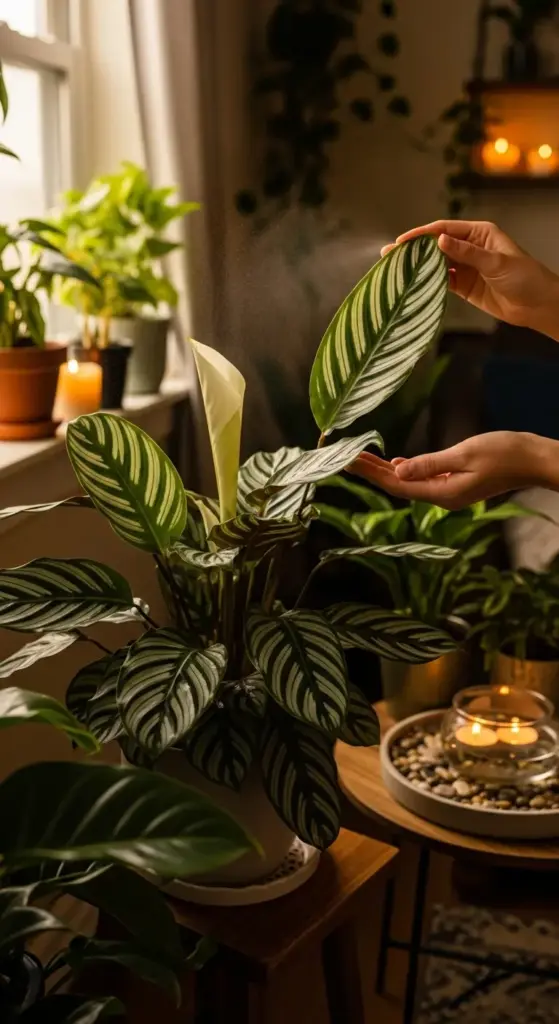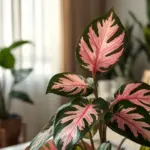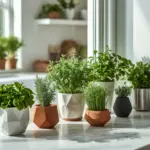7. Calathea White Star

The first time I witnessed my Calathea White Star doing its evening prayer ritual, I literally called my mom to tell her about it. I’m not even kidding – I was that excited about watching leaves move.
This plant turned me into one of those people who talks to their plants.
I’ve had mine for almost three years now, and I still find myself checking on it throughout the day just to see what position the leaves are in. It’s like having a living, breathing piece of art that changes constantly.
Low-Light Magic for City Living
Living in a cramped apartment with north-facing windows taught me that most “low-light” plants are actually just tolerating poor conditions, not thriving in them.
Calathea White Star is different – it genuinely prefers dimmer conditions.
I keep mine about 8 feet from my only decent window, and it’s the happiest plant in my collection.
The white striping on the leaves actually gets more pronounced in lower light conditions. When I first got it, I made the mistake of putting it in my brightest spot, and those gorgeous white markings started fading.
Urban apartments with limited natural light are perfect for this plant. Mine sits in what I call the “plant graveyard” corner where I’ve killed three other plants, and it absolutely thrives there.
The key is consistent, gentle light rather than bright, direct sun. Even fluorescent office lighting works well for these plants.
The Daily Dance That Never Gets Old
Okay, I need to prepare you for how addictive the prayer plant movement becomes. These leaves literally fold up at night like hands in prayer, then open back up in the morning.
It’s called nyctinasty, and it happens every single day without fail.
I’ve timed mine – the leaves start their evening routine around 6 PM and are fully closed by 8 PM. In the morning, they gradually unfold as the light increases.
The movement is controlled by tiny joints at the base of each leaf called pulvini. They respond to light changes and internal circadian rhythms, which is honestly mind-blowing when you think about it.
Guests always think I’m making it up until they see it happen. I’ve had people sit and watch my plant for an hour just to witness the movement.
The best part? Each leaf moves independently, so you get this gorgeous choreographed dance happening at slightly different times across the whole plant.
Humidity Hacks Using Stuff You Already Own
Let’s be real about Calathea humidity requirements – everyone makes it sound like you need to recreate the Amazon rainforest in your living room.
Here’s what actually works without buying expensive equipment.
I use the pebble tray method, but with a twist. Instead of just water and pebbles, I add a few drops of liquid fertilizer to the water. As it evaporates, it creates a slightly nutrient-rich microclimate.
My favorite hack? I keep a large decorative bowl filled with water and floating candles near my plant grouping. It looks intentional, adds humidity, and creates a cozy ambiance.
During winter when heating systems dry everything out, I’ll boil water for tea and carry the steaming kettle past my Calathea a few times. Sounds weird, but it works.
Grouping with other plants is probably the most effective method though. I keep my White Star with my other humidity lovers, and they create their own little ecosystem.
Leaf Care That Keeps Them Picture-Perfect
Those stunning white-striped leaves are the whole point of this plant, so keeping them pristine is crucial. I learned some hard lessons about proper leaf care.
Dust is the enemy of beautiful Calathea leaves.
I wipe mine down weekly with a damp microfiber cloth, being super gentle around those delicate white markings. Never use leaf shine products – they clog the pores and can actually damage the variegation.
For stubborn spots, I use distilled water with a tiny drop of mild dish soap. Tap water leaves mineral deposits that make the leaves look cloudy.
The white stripes are more delicate than the green parts of the leaf. I’ve accidentally rubbed off sections of white variegation by being too aggressive with cleaning.
Shower time works great too – I bring mine into the bathroom during my shower about once a month. The steam cleans the leaves naturally while adding humidity.
Troubleshooting Before You Panic
Let me save you from the mistakes that nearly killed my first Calathea White Star. These plants have a reputation for being dramatic, but most problems are totally preventable.
Brown leaf tips are almost always water quality issues. I switched to distilled water two years ago and haven’t had brown tips since.
Curling leaves usually mean low humidity or inconsistent watering. Don’t just increase watering though – check your humidity situation first.
Yellow leaves are normal aging, especially the older, lower leaves. Don’t panic and change your entire care routine when you see one or two yellow leaves.
The biggest mistake I made? Overwatering when I saw problems. Calatheas hate wet feet more than they hate being slightly dry.
Spider mites love these plants because of the humidity they prefer. Check regularly for tiny webs, especially during winter when indoor air is drier.
If your plant stops doing the prayer movement, it’s usually stressed about something – light, water, or humidity. Don’t worry, it’ll start moving again once conditions improve.
Root rot is the plant killer with Calatheas. If you catch mushy stems early, you can often save the plant by repotting in fresh, well-draining soil and cutting back on water.
Conclusion
These seven exotic houseplants prove that rare doesn’t mean difficult – it just means nurseries prefer selling you the same old varieties over and over again!
Each of these beauties will transform your space into a sophisticated botanical haven while requiring minimal effort from your busy schedule.
Ready to become the plant parent your friends envy? Start with just one of these stunning specimens and watch how it elevates your entire home’s aesthetic.
Your Instagram feed (and your guests) will thank you! Which rare beauty will you choose first to begin your exotic plant journey?









GIPHY App Key not set. Please check settings